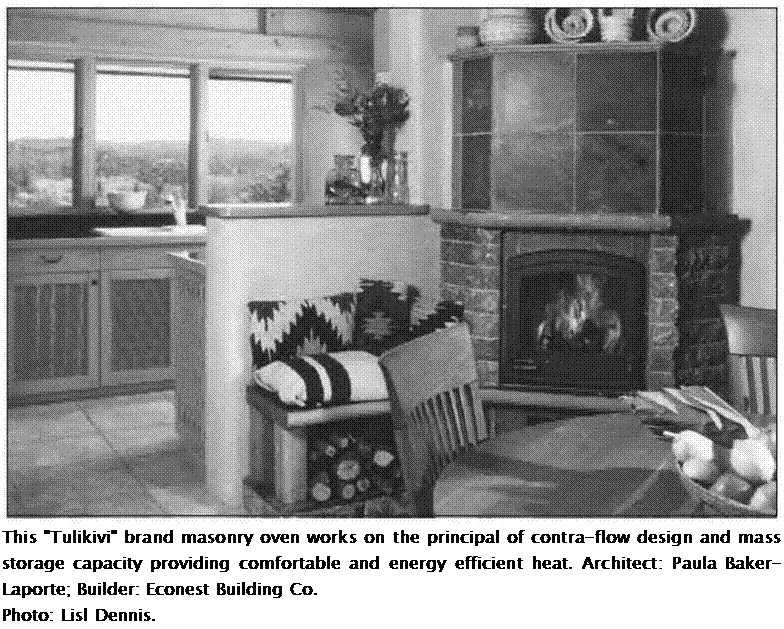Residential Heating and Cooling
Methods of heating, cooling, and ventilating homes have many important health ramifications that will affect us long after the initial building materials have outgassed and reached a neutral state. If we lived in a pristine natural environment with low humidity and mild temperatures, we would be able to condition our homes without mechanical assistance by means of solar gain, shading, and crossventilation. Residents throughout most of North America do not have this luxury. Cold and cloudy winters, hot and humid summers, and polluted or pollen-filled air are realities from which homes must shelter occupants.
We have come to expect a level of comfort and temperature control in our homes undreamed of by our not-too-distant ancestors. Along with the increased comfort level, we have unwittingly come to accept many health problems associated with heating and cooling
 |
systems. In fact, more than any other building system or component, heating and cooling methods can be a major cause of sick building syndrome. Some of the problems include:
• toxic fumes from gas, oil, or propane fuels that work their way into the building envelope through leaky supply lines, from insufficiently ventilated or improperly sealed mechanical rooms, and from open combustion appliances
• backdrafting of hazardous and sometimes deadly gases into the living space from flues
• infiltration of pollutants from outside the building envelope resulting from depressurization
• fried dust resulting from hot surface temperatures on heating appliances
• circulation of dust through an unfiltered forced-air heating system
• contamination from mold growing in the ductwork and air conditioning equipment
• fiberglass fibers from ductwork insulation that circulate in the living space
In the following section we focus on ways of reducing the need for mechanical heating and cooling. Later in this chapter we present guidelines for healthier heating and cooling installations, language for specifications, and maintenance suggestions that will help eliminate some of the problems mentioned above.
Reducing Heating and Cooling Loads Through Design Strategies
The application of a few simple design and planning principles can greatly reduce the amount of mechanical heating and cooling required to live comfortably, thereby improving health and lowering energy consumption. In designing your home for energy efficiency, consider the following suggestions.
Create an Energy-Efficient Building Envelope
• Choose an exterior wall system with a high insulation value.
• Choose interior wall and floor systems with high levels of thermal mass to assist in
 |
keeping things cool in summer and retaining heat in winter.
• Seal cracks and joints to prevent unwanted infiltration and exfiltration.
• Choose a high insulation value for the ceiling. This measure will be especially cost effective because most heat escapes through the roof.
Consider the Surrounding Site as an Extension of Your Climate-Control Design
• Make use of deciduous trees to shade in summer and allow solar gain in winter.
• Observe prevailing wind patterns when planning for natural ventilation.
• Consider using trees as windbreaks to lower the heating load created by cold winter winds.
• Situate your home as far away from pollution sources as possible so that the site can provide a quality air supply for home ventilation.
Take Advantage of Solar Heat
• Orient the home to take advantage of solar gain.
• Plan fenestration (arrangement of doors and windows) for the desired amount of heat gain.
• Make use of overhangs and sun angle information to prevent overheating in summer.
• Use light colors to reflect heat and dark colors to absorb and store heat.
• Provide thermal mass for heat storage.
• Provide cross-ventilation to facilitate nat-
 |
ural air exchange and to provide cooling in summer.
• Use thermal window-shading devices to control heat loss.
• Use specialized window coatings to enhance solar gain where desired and block unwanted heat gain.
Become a More Active Participant in Temperature Control
• Open and close windows to provide fresh air and control temperature.
• Open and close thermal shading devices to control heat gain and loss.
• Utilize automated thermostat controls to economize on heating and cooling when you are absent or asleep.
• Be willing to add and subtract layers of
clothing to allow for a greater range of acceptable temperatures.
• Consciously acclimatize your body to a broader comfort range.
Each heating and cooling system has advantages and disadvantages that you must weigh carefully when choosing a system that best fits your needs and budget. Once you have made a choice, there are several design, construction, and maintenance considerations that will optimize performance and minimize the health risks of the system. In the preliminary design phase, you and your architect must consider factors such as the location of the mechanical room. During the construction phase, the choice of materials and installation procedures






Leave a reply